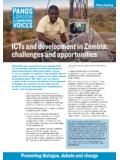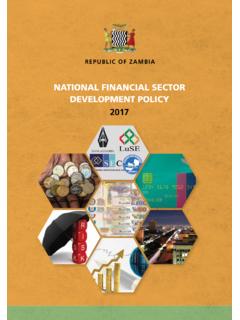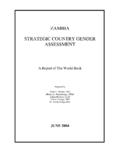Transcription of Thematic evaluation series - Food and Agriculture …
1 OFFICE OF EVALUATIONT hematic evaluation seriesMarch 2017 evaluation of FAO s contribution to the reduction of rural poverty through Strategic Programme 3 Thematic evaluation SERIESE valuation of FAO s contribution to the reduction of rural poverty through Strategic Programme 3 FOOD AND Agriculture ORGANIZATION OF THE UNITED NATIONSOFFICE OF EVALUATIONM arch 2017 Food and Agriculture Organization of the United NationsOffice of evaluation (OED)This report is available in electronic format at: designations employed and the presentation of material in this information product do not imply the expression of any opinion whatsoever on the part of the Food and Agriculture Organization of the United Nations (FAO) concerning the legal or development status of any country, territory, city or area or of its authorities, or concerning the delimitation of its frontiers or boundaries.
2 The mention of specific companies or products of manufacturers, whether or not these have been patented, does not imply that these have been endorsed or recommended by FAO in preference to others of a similar nature that are not mentioned. The views expressed in this information product are those of the author(s) and do not necessarily reflect the views or policies of FAO. FAO 2017 FAO encourages the use, reproduction and dissemination of material in this information product. Except where otherwise indicated, material may be copied, downloaded and printed for private study, research and teaching purposes, or for use in non-commercial products or services, provided that appropriate acknowledgement of FAO as the source and copyright holder is given and that FAO s endorsement of users views, products or services is not implied in any requests for translation and adaptation rights.
3 And for resale and other commercial use rights should be made via or addressed to further information on this report, please contact: Director, Office of evaluation (OED)Food and Agriculture OrganizationViale delle Terme di Caracalla 1, 00153 RomeItalyEmail: Photo credit (cover photos): FAOE valuation of FAO s contribution to the reduction of rural povertyiiiContentsAcknowledgements ..vAcronyms and abbreviations ..viExecutive summary ..11. Introduction .. Purpose and scope .. Methodology .. Limitations and quality assurance.
4 52. Description of Strategic Programme 3 .. Thematic areas and resources .. Delivery mechanisms .. Country programmes .. Regional initiatives .. Global knowledge products and services .. Future directions ..123. Assessment of Strategic Programme Strategic Relevance: Is FAO s approach to rural poverty reduction under the revised Strategic Framework architecture appropriate? .. Rationale for the chosen approach to rural poverty reduction .. Programme design: Are FAO interventions and delivery mechanisms adequate? .. Intervention logic.
5 Regional initiatives .. Country programming frameworks .. Design of SP3 programmes and projects .. Mainstreaming rural poverty reduction .. Capacities in decentralized Communication: Is there a common understanding of the intervention logic? .. Partnerships: Is FAO leveraging partnerships appropriately? .. Resource mobilization .. Effectiveness and sustainability: Is the SP3 strategy bearing signs of results? Are the results sustainable?.. Gender equality ..224. Conclusions and recommendations ..25 evaluation of FAO s contribution to the reduction of rural povertyivTables and boxesTablesTable 1: SP3 selected instruments by area of work.
6 8 Table 2: SP3 contributions in selected themes ..22 Table 3. SP3 outputs contributing to FAO gender equality policy objectives ..23 Table 4: Examples of global products and their contribution to gender equality ..23 BoxesBox 1. evaluation questions ..4 Box 2. SP3 theory of change to achieve rural poverty reduction (2018-2021) ..12 Box 3: The significance of supplementary wage income on rural poverty reduction ..13 Box 4: CELAC Plan for Food and Nutrition Security and Eradication of Hunger 2025 ..15 Box 5: SP3 and the SDGs ..18 Box 6: Strategic partnerships with ILO, IFAD and UNICEF.
7 20 evaluation of FAO s contribution to the reduction of rural povertyvAcknowledgementsThe Office of evaluation would like to thank all those who contributed to this exercise. The evaluation team, led by Carlos Tarazona, Senior evaluation Officer, consisted of SV Divvaakar (India), Julia Compton (United Kingdom), Alvaro Ramos (Uruguay), Norma Correa (Peru), Fabio Veras (Brazil), Asyl Undeland (Kyrgyzstan/USA), Jacques de Graaf (The Netherlands), Mohamed Mohieddin (Egypt), James Gasana (Rwanda) and Bola Akanji (Nigeria), The team was ably supported by Ahmedou Ould Abdallahi and Veridiana Mansour, evaluation Officers, and Nadine Monnichon, Administrative Assistant.
8 An Expert Panel provided independent advice and guidance to the evaluation and usefully commented on this report. It was composed by Leila Pakkala (Regional Representative for Eastern and Southern Africa, UNICEF), Rachel Sabates-Wheeler (Research Fellow, Institute of Development Studies), Bradford Barham (Professor, University of Wisconsin-Madison s Agricultural and Applied Economics Department) and Gustavo Gordillo de Anda (Independent consultant, Mexico).The evaluation was carried out with the invaluable assistance of the core team of Strategic Programme 3 (SP3), including Benjamin Davis, SP3 Team Leader; Maya Takagi, Deputy SP3 Team Leader; David Conte, Senior Strategic Advisor; Philippe Ankers, Senior Programme Advisor and leader for Outcome 1 (Access and Empowerment); Peter Wobst, Senior Programme Advisor and leader for Outcome 2 (Decent rural Employment); Natalia Winder-Rossi, Senior Programme Advisor and leader for Outcome 3 (Social Protection).
9 Daniela Kalikoski, Programme Advisor; Ana de la O, Programme Advisor. We are also very grateful to Rob Vos, former SP3 Team Leader; Salomon Salcedo, former leader for Outcome 1; and Vito Cistulli; former leader for Outcome 3, as well as to each of the Delivery Team Leaders within Strategic Programme 3 and their colleagues. They supported this exercise patiently and continually, investing much of their time and knowledge in the also thank the Regional Strategic Programme Coordinators, Delivery managers and focal points who contributed to this evaluation : Beth Crawford, Tacko Ndiaye, Mohamed AgBendech, Cisse Al Hassan (Africa); Xiangjun Yao, Clara Park (Asia); Raimund Jehle, Morten Hartvigsen, Katalin Ludvig (Europe and Central Asia); Adoniram Sanches Peraci, Luiz Carlos Beduschi.
10 Katalina Moyano (Latin America and the Caribbean); Pasquale Steduto; Alfredo Impiglia, Malika Martini (Near East and North Africa); as well as the staff from the over 30 FAO decentralized offices contacted by the team, the Regional Office for Africa, the Regional Office for Latin America and the Caribbean, the Regional Office for the Near East and North Africa, the Regional Office for Asia and Pacific, the Regional Office for Europe and Central Asia, the Sub-regional Office for Central Asia, the Sub-regional Office for North Africa, and the Country Offices of Mexico, El Salvador, Colombia, Paraguay, Albania, Armenia, Georgia.


















